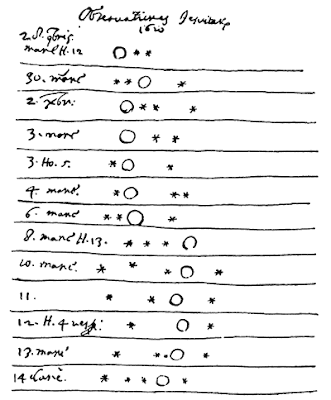
But it is neat: On Monday evening, October 26, 2009, Jupiter and the Moon will be a mere 3º apart (less than the size of your fist, at arm's length). Above: The view Monday night as predicted by Stellarium; click to enlarge.
Jupiter is currently the brightest object in our evening skies, but if you've not seen this planet with your own eyes, Monday evening presents you with perhaps the easiest opportunity ever to find it.
If you own a pair of binoculars or a small telescope, use them! The Moon looks spectacular with even the smallest optical aid, and often even small binoculars can allow you to detect Jupiter's four largest moons: the scene will appear as a bright "star" (Jupiter) surrounded by four tiny "stars" (Jupiter's four largest moons). The image below, taken by Mathew Wedel at 10 Minute Astronomy, gives you some idea:
On that note, it was exactly 400 years ago November that Galileo became the first human being to point a telescope at the sky and discovered the existence of those moons--and the existence of any object going around something other than the Earth! This represented the first direct evidence in support of the heliocentric theory of the solar system, and further fueled Galileo to uncover fundamental new truths about the nature of motion, laying the groundwork for the modern branch of science known as physics. Pretty pregnant observation, that.


Above: Galileo's own notes recording the relative positions of Jupiter's satellites over the course several days.

No comments:
Post a Comment